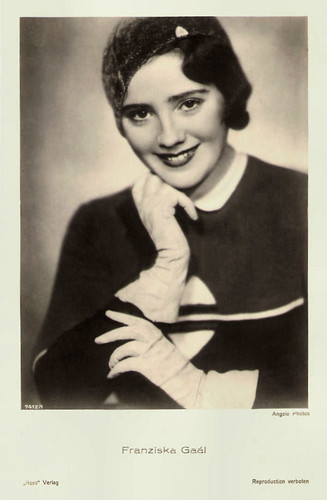
German postcard by Ross Verlag, no. 7612/1, 1932-1933. Photo: Angelo Photos.

Dutch postcard, no. 618. Photo: Filma. Franziska Gaal and Wolf Albach-Retty in Frühjahrsparade/Spring Parade (Géza von Bolváry, 1934).

German postcard by Ross Verlag, no. 9054/1, 1935-1936. Photo: Rota.

French postcard in the Entr'acte series by Éditions Asphodèle, Mâcon, no. 003/15. Photo: Collection B. Courtel / D.R. Cecil B. DeMille, Fredric March, and Franziska Gaál (in the US written as Franciska Gaal) on the set of The Buccaneer (Cecil B. DeMille, 1938). Caption: Cecil B. DeMille directs with his inseparable cinematographer Victor Milner, the stars of the film Fredric March and Franciska Gaal.
Comic timing
Franciska Gaál (in Germany Franziska Gaal) was born Fanny Silberstein or Zilverstrich (according to Filmportal.de, while other sources also write Zilveritch or Silberspitz) in Budapest in 1904. She was the thirteenth child of an affluent Jewish middle-class family.
Fanny attended the Budapest Academy of Theatre and after the First World War, she made a name as a singer, dancer and actress. Her stage name Gaál was the name of one of her acting teachers. Her screen debut in Hungary was the short silent film Az Egér/The Mouse (Lajos Gellért, 1921). Two other silent films followed, A cornevillei harangok/The Bells of Corneville (Antal Forgács, 1921) and New-York express kábel/New York Express Cable (Márton Garas, 1921).
But after these films, she focused on the stage. Several plays were written especially for her, including 'A jó tündér' (The Good Fairy, 1930) and 'Valaki' (Violet, 1931) by Ferenc Molnár. She was thus a highly successful stage actress when producer Joe Pasternak engaged her for Universal's European subsidiary Deutsche Universal.
She started with Paprika (Carl Boese, 1932) opposite Paul Hörbiger, and went on to star in several features which highlighted her comic timing and enchanting looks.
To her German films belong Gruss und Kuss, Veronika!/Greetings and Kisses, Veronika (Carl Boese, 1933) and Frühjahrsparade/Spring Parade (Géza von Bolváry, 1934), also starring Wolf Albach-Retty, Paul Hörbiger, Theo Lingen, Adele Sandrock and Hans Moser. Producer Pasternak later remade Frühjahrsparade/Spring Parade in Hollywood as a Deanna Durbin vehicle.
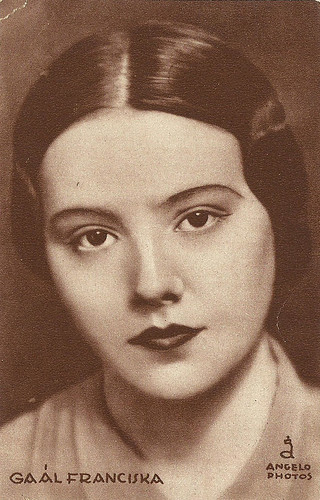
Hungarian postcard. Publisher: Globus, Budapest. Photo: Angelo Photos. Collection: Didier Hanson.
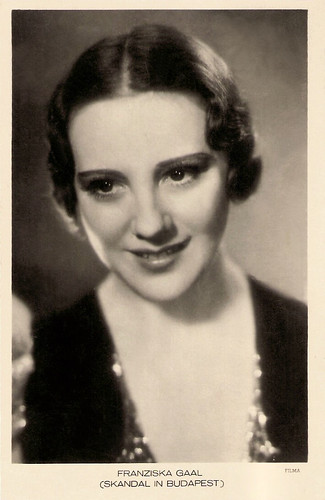
Dutch postcard by M.B. & Z. Photo: Filma. Publicity card for Skandal in Budapest/Romance in Budapest (Steve/Stefan Szekely, Géza von Bolváry, 1933).

Dutch postcard, no. 527. Photo: Filma. Franziska Gaal in Skandal in Budapest/Romance in Budapest (Steve/Stefan Szekely, Geza von Bolvary, 1933).

Dutch postcard by Filma, no. 530. Franziska Gaal in Skandal in Budapest/Romance in Budapest (Steve/Stefan Szekely, Geza von Bolvary, 1933).
Modern and witty Screwball Comedies
After the Nazis' rise to power, the Jewish Gaal couldn't continue her work in Germany. Between 1934 and 1936, she became the star of several independently produced films in Austria, which marked the height of her career.
Peter (1934) with Hans Jaray, Kleine Mutti/Little Mother (1935) with Enrico Benfer and Otto Wallburg, and Katharina – die Letzte/Catherine the Last (1936) had the same successful formula - light musical comedies built around the young soprano Gaal.
These modern and witty screwball comedies were all directed by Hermann Kosterlitz (later Henry Koster), written by Felix Joachimson and produced by Joe Pasternak for Universal Pictures in Europe. The rights of Kleine Mutti were later acquired by RKO who remade it in English as Bachelor Mother (Garson Kanin, 1939) starring Ginger Rogers and David Niven.
Her final Austrian film was Fräulein Lilli/Miss Lilli (1936) with the Jewish actors Hans Jaray and Szöke Szakall as her co-stars. In order not to make his production company Projektograph Film a target for anti-Semitic fanatics, producer Oskar Glück founded especially for this production Opus Film GmbH.
As a director, he contracted German emigrant Hans Behrendt. The shooting was turbulent and according to German Wikipedia the role of diva Gaál with her 'stormy temperament' was 'unfortunate'. She refused to work with Behrendt, nor with a second emigrant director Max Neufeld. So the film was finished by a third Jewish director, Robert Wohlmuth. Nazi Germany banned the film, and also after the war the film was not a success.
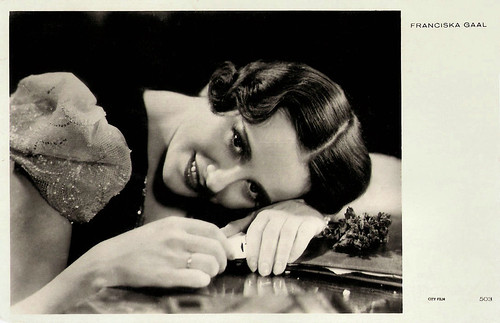
Dutch postcard by City Film, no. 503.
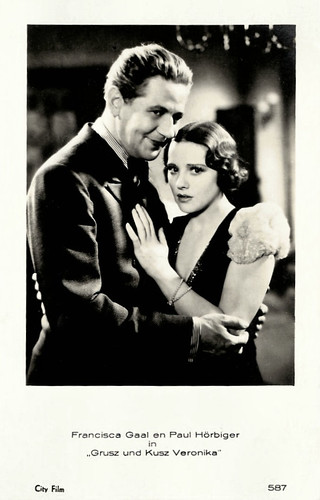
Dutch postcard by City Film, no. 587. Publicity still for Gruss und Kuss - Veronika (1933) with Paul Hörbiger.
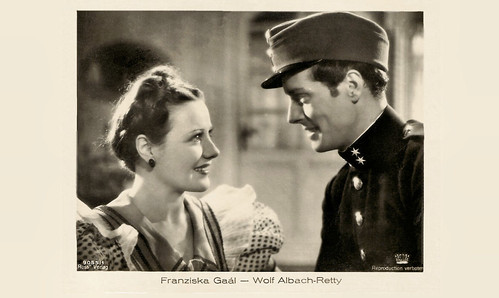
German postcard by Ross Verlag, no. 9055/1. The photo is a still from Frühjahrsparade (1934), with Wolf Albach-Retty. The photo was cut out of the card by a former owner. We photoshopped the edges.

German postcard by Ross Verlag, no. A 1462/1, 1937-1938. Photo: Paramount. Franziska Gaal in The Buccaneer (Cecil B. DeMille, 1938).
Impoverished and unnoticed
In 1937, Franciska Gaál and the rest of the Universal team left Austria and emigrated to the USA. There she was groomed to become a Hollywood star by Cecil B. DeMille. Gaál co-starred in his epic adventure film The Buccaneer (Cecil B. DeMille, 1938) opposite Frederic March, but her performance was merely decorative according to critics.
Next, she appeared at Bing Crosby's side in the musical Paris Honeymoon (Frank Tuttle, 1939), but again to no avail. The last of her three Hollywood screen appearances was in MGM's Cinderella comedy The Girl Downstairs (Norman Taurog, 1939). She starred as a scullery maid, romanced by callous playboy Franchot Tone.
In 1940, Franciska Gaál returned to Budapest to attend to her mother's illness and was then forced to remain in Hungary through WW II. She survived the war and Nazi prosecution, hidden in a bombed-out estate.
After the war, she tried to make a comeback opposite Theo Lingen and Hans Moser in Renée XIV (Ákos Ráthonyi, 1946), but the film was never completed. In 1947, she returned to the US and replaced Eva Gabor in the Broadway production 'The Happy Time' (1951). However, she didn't surface again as an actress.
Later, she worked as an acting teacher at the theatre school of Erwin Piscator. Franciska Gaál was married to Dr. Francis Dajkovitch, who passed away in 1965. In 1972, the former star of the German sound comedy died in New York, impoverished and unnoticed by the public.

Austrian postcard no. A.E. 59. Caricature by Kora. Collection: Marlene Pilaete.
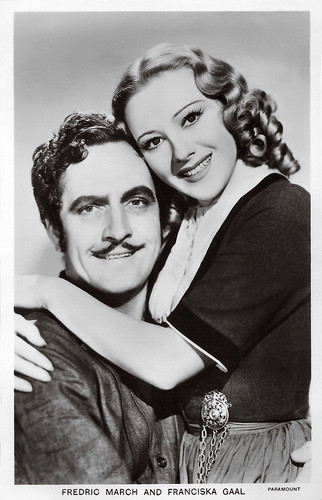
British postcard in the Film Partners Series, London, no. P 243. Photo: Paramount. Fredric March and Franciska Gaal in The Buccaneer (Cecil B. DeMille, 1938).

Vintage postcard by EmBPo, no. 3175. Photo: Polarfilma.
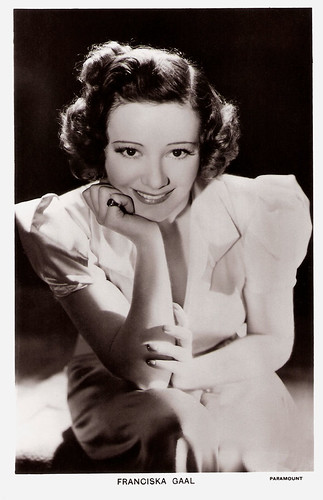
British postcard in the Picturegoer Series, London, no. 1197. Photo: Paramount.
Sources: The West Australian (Trove), Filmportal.de, Thomas Staedeli (Cyranos), AllMovie, Wikipedia (English and German) and IMDb.
This post was last updated on 24 April 2024.
No comments:
Post a Comment